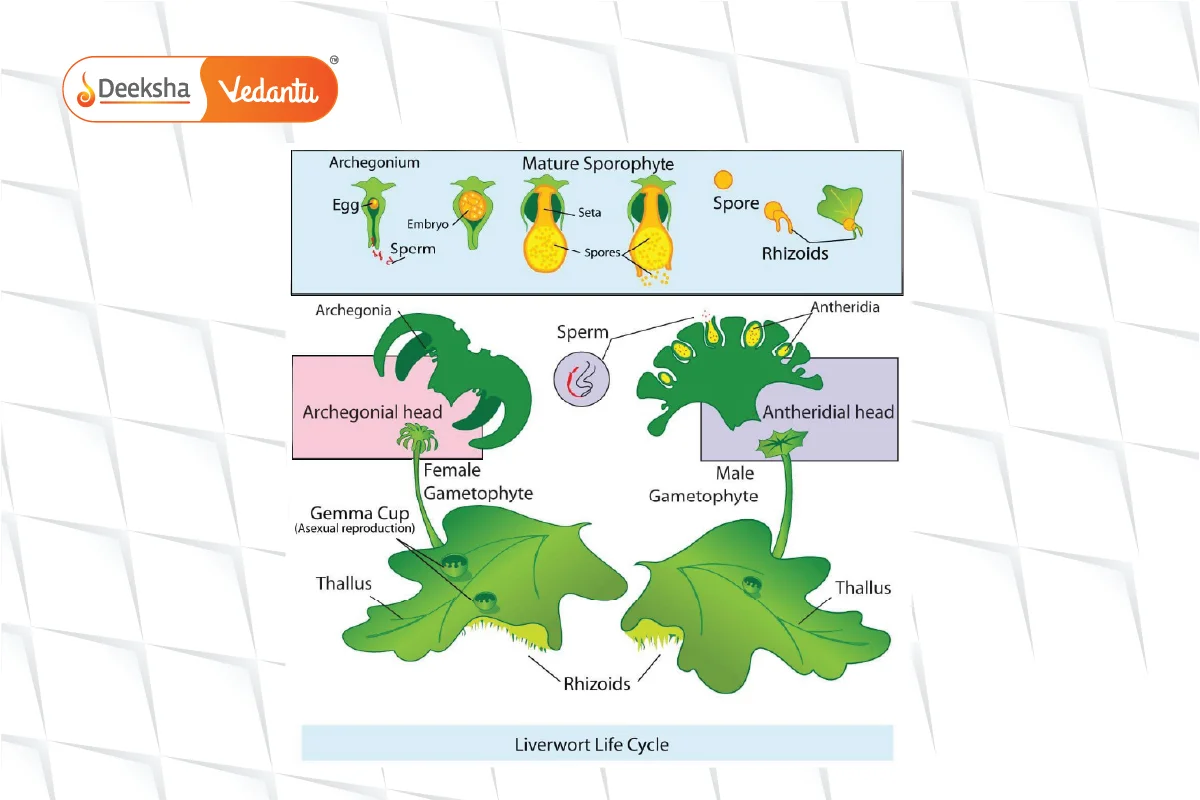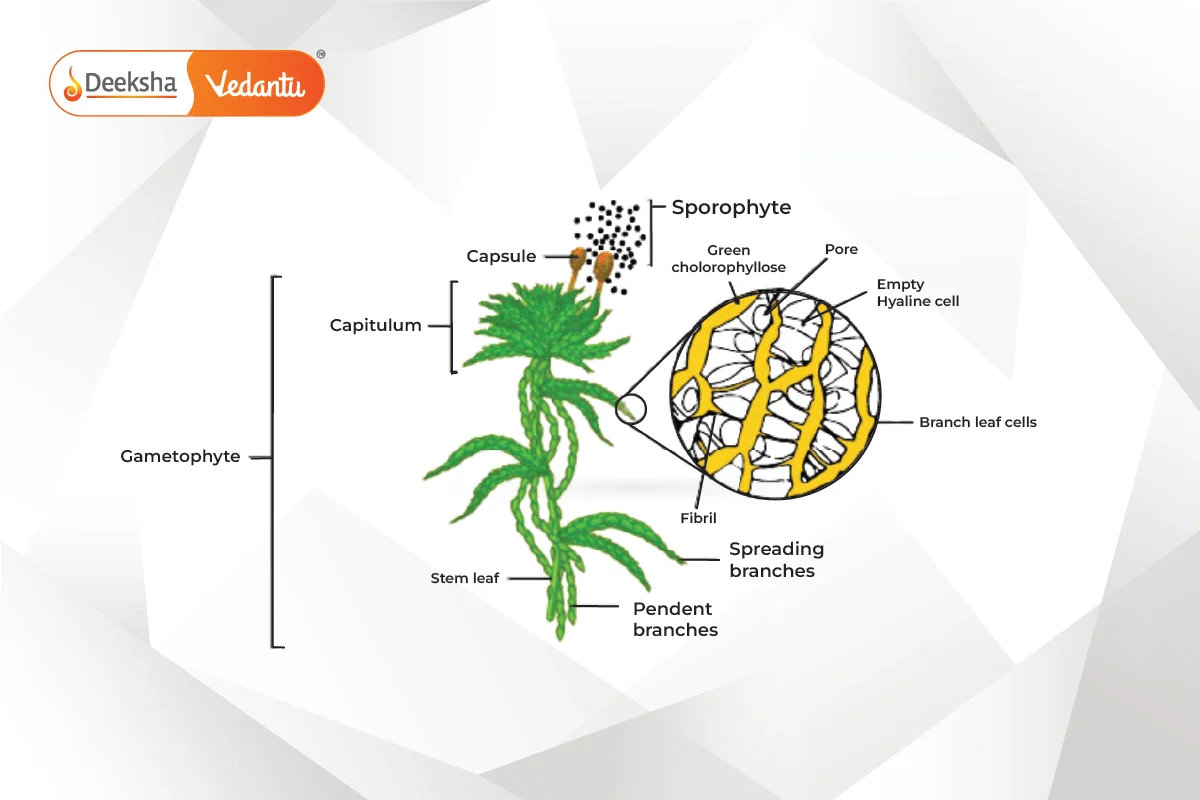Bryophytes, derived from ‘Bryon’ (moss) and ‘phyton’ (plants), include mosses, hornworts, and liverworts. These small, non-vascular plants thrive in shady, damp areas and reproduce through spores instead of seeds. Bryology is the study of bryophytes.
Why are Bryophytes called Amphibians of Plants?
Bryophytes are called “amphibians of the plant kingdom” because, although they live on land, they need water for sexual reproduction.
Habitat of Bryophytes
Bryophytes grow in various habitats, from shady, damp places to extreme conditions like the arctic and deserts. They can survive where vascular plants can’t because they don’t need roots for nutrient uptake. Some can tolerate long periods of dryness and resume photosynthesis when rehydrated. They often grow on rocks, soil, or decaying matter.
General Characteristics of Bryophytes:
- Grow in damp, shaded areas
- Thallus-like body, prostrate or erect
- Attached to the substrate by rhizoids (root-like structures)
- Lack true roots, stems, and leaves
- No vascular system (xylem, phloem)
- Show alternation of generations with a dominant gametophyte (haploid) stage
- Gametophyte bears sex organs and is photosynthetic
- Sporophyte (diploid) depends on gametophyte for nutrition
- Sporophyte produces spores through meiosis, leading to gametophyte formation
Classification of Bryophytes
Bryophytes are divided into three classes:
- Hepaticopsida (Liverworts):
- Examples: Riccia, Marchantia
- Thalloid or foliose gametophyte
- Asexual reproduction via fragmentation or gemmae
- Sexual reproduction involves antheridia and archegonia

- Anthocerotopsida (Hornworts):
- Examples: Anthoceros, Megaceros
- Thalloid gametophyte with a single chloroplast per cell
- Sporophyte has foot, meristematic zone, and capsule
- Reproduce asexually via fragmentation and tubers

- Bryopsida (Mosses):
- Examples: Funaria, Polytrichum
- Gametophyte has protonema and leafy gametophore
- Sporophyte with foot, seta, and capsule
- Asexual reproduction via budding and fragmentation

Ecological Importance of Bryophytes
- Colonize and decompose rocks, aiding soil formation
- Act as soil binders
- Play a role in bog succession, forming habitats for other plants
- Prevent soil erosion and reduce water runoff
- Help in nutrient recycling
- Build rock-like deposits in water bodies (e.g., Bryum)
Importance of Bryophytes
- Medicinal Uses:
- Sphagnum used in surgical dressings
- Marchantia used to treat tuberculosis
- Sphagnum decoction for hemorrhage and eye infections
- Peat-tar as an antiseptic
- Research:
- Used in genetic research
- Packing Material:
- Dried mosses for packing fragile goods and live plants
- Food:
- Provide food for some animals
- Indicators:
- Some bryophytes indicate soil acidity or basicity
- Seedbeds:
- Used for rooting cuttings and maintaining soil acidity
- Peat Formation:
- Sphagnum forms peat, used as fuel and in various industries
- Improves soil texture in horticulture
FAQs
Peat is a dark substance formed from the compression and partial decomposition of mosses, used as fuel and in various industries.
Bryophytes are used in medicine, research, packing materials, as indicators of soil conditions, and in horticulture.
Bryophytes help in soil formation, prevent erosion, aid in bog succession, and recycle nutrients.
Bryophytes are classified into three classes: Hepaticopsida (liverworts), Anthocerotopsida (hornworts), and Bryopsida (mosses).
Bryophytes have a thallus-like body, lack vascular tissue, and show alternation of generations with a dominant gametophyte stage.
They are called amphibians because they live on land but require water for sexual reproduction.
Bryophytes are small, non-vascular plants including mosses, liverworts, and hornworts that thrive in damp and shady environments.
Related Topics
- What is Hemoglobin
- Important Notes For NEET Biology – Cell Cycle and Cell Division
- Important Notes For NEET Biology – Body Fluids and Circulation
- Important Notes For NEET Biology -Shapes of Bacteria
- Epithelial Tissue
- Protozoa
- Important Notes For NEET Biology – The Living World
- Types of Fermentation
- Plant Hormones
- Paramecium
- Important Notes For NEET Biology – Breathing and Exchange of Gases
- Marchantia
- Plasma Membrane Structure
- Plasmid
- Connective Tissue












Get Social